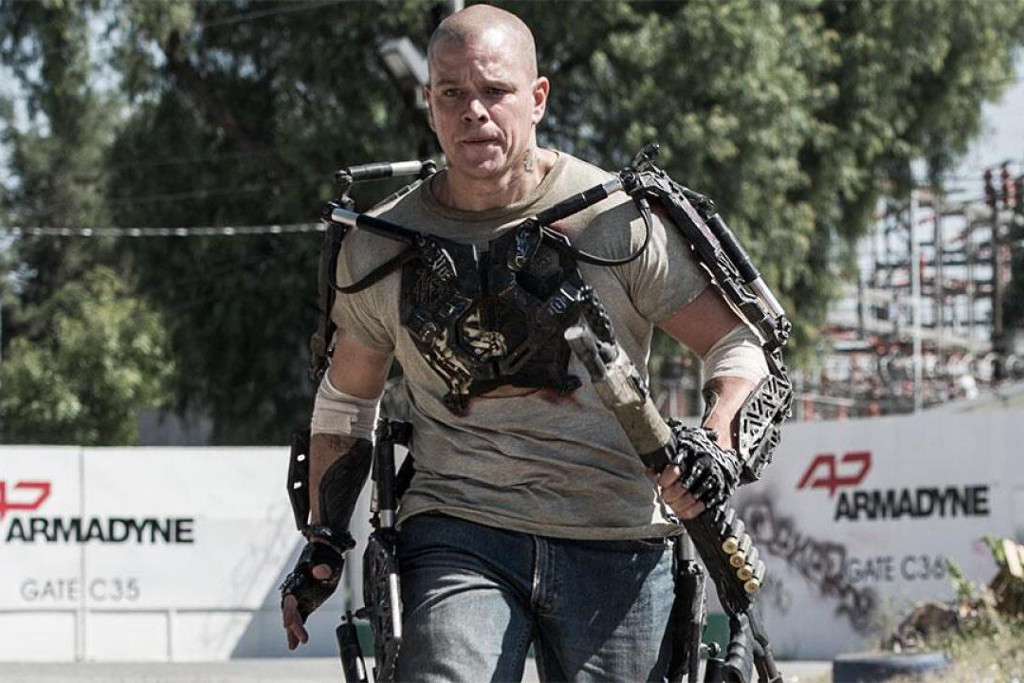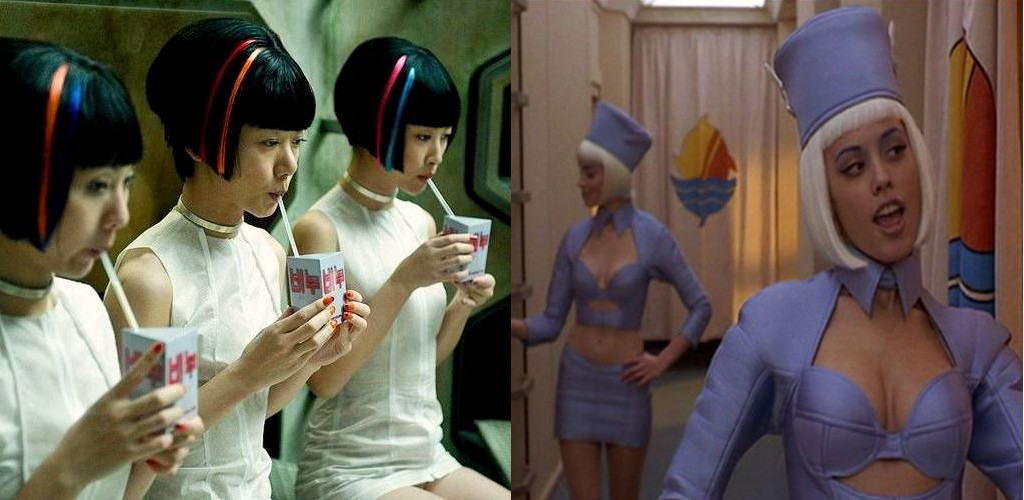The Future Needs Some Better Clothes
Elysium is set in 2154, so why is Matt Damon wearing a T-shirt and jeans?

In Neill Blomkamp’s new film Elysium, Matt Damon plays a factory worker in an overpopulated future Los Angeles who yearns to reach the orbiting space station where the world’s super-rich live in perpetual health and luxury. Fatally irradiated in a workplace accident, he artificially augments his failing strength with an exoskeleton wired into his central nervous system, right through his T-shirt and jeans.
Wait, hang on! This happens in 2154. Why is Matt Damon even wearing a T-shirt and jeans? (And sneakers?) That’s like us wearing frock coats, waistcoats and cravats from 1872.
Okay, let’s assume L.A. fashion hasn’t changed much because people are so poor they wear and trade old clothes. But Jodie Foster and William Fichtner, who respectively play Elysium’s security chief and the boss of Damon’s factory, wear business suits. Even with access to all the future fashions Elysian money can buy and Earth sweatshops can churn out, these one-percenters still choose Armani!
I wonder if Elysium costume designer April Ferry — who’s won awards for her work on period dramas Rome (2005-07) and The Edge of Love (2008) — is uncomfortable working in a futurist idiom. Her costumes for the 2009 Bruce Willis film Surrogates (based on a comic book set in 2054) are also pretty contemporary, leaving the work to gadgets and CGI to create the illusion. Ferry also worked on the forthcoming RoboCop reboot, though I’m not sure if she’s responsible for the revised RoboCop suit that fans of the original wouldn’t even buy for a dollar.
Using film costumes to convey ‘futuristicity’ can be a tricky balancing act. They have to extrapolate advances in fashions and fabric technologies in ways that are plausible for the character and the story world, and yet have to look relatable to us now. So how are other recent films tackling the issue?
–
Uniformed Futurism
Uniforms can signify utopian collectivism and freedom from markers of inequality, or a totalitarian regime imposing its will on the public. Characters in white uniforms can be scientists both honourable and sinister, or institutionalised patients and prisoners, while black uniforms often reference fascists’ history of dressing in that colour.
In William Ware Theiss’s now-iconic Star Trek uniforms, the lack of traditional military elements such as belts, epaulettes and buttons conveys that Starfleet is a diplomatic, non-aggressive organisation. Later versions added structure through shoulder padding and colour blocking.
True to its title, Star Trek Into Darkness prominently features the underlying black turtlenecks, usually only glimpsed in the V-neckline of the over-tunics. The new film’s Kirk and Spock wear black on the outside because black is how they feel on the inside. The removal of their Starfleet tunics also dramatises that they’ve ‘gone rogue’.
–
Retro-Futurism
Fashion is cyclical, not linear; past styles bring their associations to fresh contexts. The tunics of Logan’s Run (1976) reference both the hedonistic decadence and the rule of the state in imperial Rome, while A Clockwork Orange (1971) disquietingly dresses its English droogs in a mashup of 19th-century styles: bourgeois bowler hats and canes with proletarian boots and braces.
In The Host (2013), alien colonists have transformed a future Earth into a mid-20th century utopia. The bureaucratic Seekers, led by Diane Kruger, wear tailored white suits, while ordinary citizens wear simple, mid-century-styled apparel — demure blouses and skirts, high-waisted capri pants, bowling shirts — in muted colours. The look evokes the obedient conservatism we disparagingly associate with the 1950s, which is referenced in films from 1998’s Pleasantville to 2004’s Stepford Wives remake.
The titular aerospace agency in Gattaca (1997) is reminiscent of old-school American tech corporations such as IBM. But Ethan Hawke’s black suit, white shirt and black tie peg him as a Man in Black: a rogue figure from mid-century UFO conspiracy theory whose neat, inconspicuous corporate apparel enables him to slip unnoticed through society.
In Brandon Cronenberg’s dystopian celebrity satire Antiviral (2012), Caleb Landry Jones is another Man in Black, covertly smuggling celebrity viruses in his own body from the corporate clinic where he works. And in the sci-fi parable In Time (2011), Justin Timberlake dons a similar suit to gatecrash a party and abduct Amanda Seyfried.
In Time uses adult lifespan as a metaphor for capital; the rich are almost immortal, while the harried poor literally work to live. Costume designer Colleen Atwood clothes the time-rich in 1930s-pastiching glamour, evoking the stark wealth division during the Great Depression.
–
Couture Futurism
Time travellers always find the future strange and outlandish, yet right now we mock the zany styling of haute couture runway shows. Couture futurism suggests that extremely avant-garde fabrics, silhouettes and textures might one day come to seem ordinary. The cartoonish Harajuku/K-pop costumes in Cloud Atlas’s Neo-Seoul owe a debt to Jean-Paul Gaultier’s still-edgy designs for The Fifth Element (1997).
However, some couture futurism becomes so redolent of its period that it becomes retro-futurism… like the 1960s space-age aesthetic by designers including Pierre Cardin, Paco Rabanne and André Courrèges. British couturier Hardy Amies made space clean and anodyne with his groovy 1968 costumes for 2001: A Space Odyssey. That same year, Paco Rabanne and Jacques Fonteray created Jane Fonda’s kinky costumes in Barbarella.
For me, The Hunger Games is far more successful than Elysium in delineating rich and poor, because we already think of couture as an indulgence for the frivolous super-wealthy. The colourful Capitol seems grotesquely decadent to Katniss Everdeen, whose well-worn clothes reference Dorothea Lange’s Depression-era documentary photographs.
–
Organic Futurism
Amid cold future technologies, costumes can emphasise humanity through organic forms and textures. In The Matrix (1999), characters within the Matrix’s virtual space wear glossy, strongly tailored outfits in bold black, white, red and plum. Outside, they wear shapeless, rough-textured knits in muted beiges and greys, with stretched-out necklines and visible holes.
This hippyish juxtaposition reaches its apotheosis in The Matrix Reloaded’s cringeworthy Zion rave scene. Similarly, the humans resisting the alien colonisers in The Host wear earthy greens and browns to show they belong here. And in Cloud Atlas’s ‘Big Island’ story, set in 2321, Halle Berry’s character Meronym wears a pale jumpsuit with a weird homespun wrap.
The doomed protagonists of Never Let Me Go (2010) also wear greens, browns, greys and burgundies to assert their humanity… within a system that views them as cattle. The colours grow more muted as their organs are progressively harvested. The clothes are shabby and retro-styled because they’re hand-me-downs, layered shapelessly in the British country style, making the characters look like WWII child evacuees. It’s a poignant association, since they’ll never find the protection they seek.
Organic futurism can also assign new technological purposes to natural forms and materials. After Earth, that much-maligned star vehicle for Will and Jaden Smith, has lovely, thoughtful design. Spaceships evoke the sea, full of fluted, kelp-like ribbons, and pale-coloured ribbing like bones or driftwood. And Jaden’s high-tech jumpsuit mimics nature to help him survive a hostile environment: it has a reptilian texture, sugar-glider membranes, a pouch-like backpack and chameleonic colour-changing properties.
–
Grunge Futurism
Dan O’Bannon’s grungy production design for John Carpenter’s Dark Star (1974) set the tone for Alien (1979), which O’Bannon co-wrote. The Nostromo crew are menial workers like long-haul truckies or oil-rig hands, customising their uniforms to assert independence from their corporate masters.
Duncan Jones’s Moon (2009) pays homage to this aesthetic. Sam Rockwell’s jumpsuit is a similar blue-grey to Sigourney Weaver’s, and he also wears a Hawaiian shirt like Harry Dean Stanton’s. His clothes grow baggier and more slovenly the longer he’s on his three-year moon mission.
Meanwhile, the Mad Max franchise cemented the post-apocalyptic grunge aesthetic. This punk-inspired collage of leather, metal and found objects is scavenged from a destroyed civilisation; Mel Gibson’s tattered leathers represent the ruins of Max’s former life as a road patrol cop. The Terminator, a killer robot from 2029, steals his outfits first from street punks, then from grizzled bikers.
Grunge futurism can be a playful critique of militarism, as in the underrated Tank Girl (1995). Often, though, grunging up ordinary casual clothes is a lazy shortcut to depict underclass heroes — such as Elysium’s Matt Damon — as recognisable everymen. In last year’s Total Recall remake, set sometime after 2084, Colin Farrell also wears jeans, T-shirts and jackets.
Pacific Rim, set in 2020-25, shows uniformed futurism dissolving into grunge futurism as the Pan Pacific Defense Corps loses its government funding. Idris Elba’s uniform becomes a business suit, but maintains the same aggressively triangular torso to communicate his authority. Rinko Kikuchi wears navy-blue combat pants, boots and greatcoat — a grown-up version of the sky-blue overcoat Mako wore as a child — but in private, she dons a soft beige cardigan.
Other characters run the futurist gamut: the Shatterdome mechanics’ indistinguishable Bond-henchmen uniforms; the retro-futurism of eccentric scientists Charlie Day and Burn Gorman and black marketeer Ron Perlman; the aviator grunge of the Jaeger pilots. It’s appropriate that a film about cooperation should adopt a pluralistic aesthetic.
“All those years I spent living in the past, never really thought about the future,” says the film’s protagonist Raleigh Becket, “…until now.”
–
Mel Campbell is a freelance journalist and cultural critic. She is the founding editor of online pop-culture magazine The Enthusiast and the national film editor of the Thousands network of city guides. Her debut book, Out of Shape: Debunking Myths about Fashion and Fit, is out now through Affirm Press.
